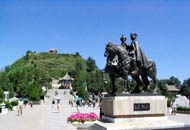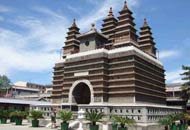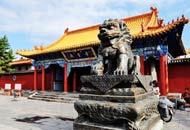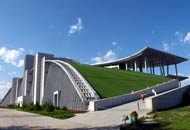Situated in the north-west of the intersection at Xinhua East Street and Dongerhuan Road, Hohhot, the Inner Mongolia Museum is adjacent to Wulanqiate Grand Theater with a main building area of more than 50,000 square meters, a 4-story main structure and a 6-story local structure. It has a unique design and advanced equipment composed of the exhibition hall, a cultural relic storeroom, the audience service area, the business district of scientific research and a multi-functional hall. The museum expresses the strong modern elements, the regional features and the local minorities’ characteristics; it is known as an “Encyclopedia” which reflects hundreds of millions of years’ history of ecological changes and the developments of the civilization across the grasslands.With its unique culture, national characteristics and regional features, Inner Mongolia Museum plays an important role in the development of Inner Mongolian business of cultural relics & museology and tourism. It is also a significant window for domestic and foreign tourists to visit Inner Mongolia and know the history and grassland culture of Inner Mongolia.
On the roof of the main building of Inner Mongolia Museum, there’s a statue of a galloping steed, symbolizing the good luck and take-off of Inner Mongolia. This building of Inner Mongolia Museum has become a landmark of the capital of Inner Mongolia Autonomous Region since its establishment.This museum is open all the year round. Its exhibitions includes: Inner Mongolia Biological Display, Inner Mongolia Historical Relics Display, Inner Mongolia Modern Relics Display, and Inner Mongolia National Customs and Relics Display.
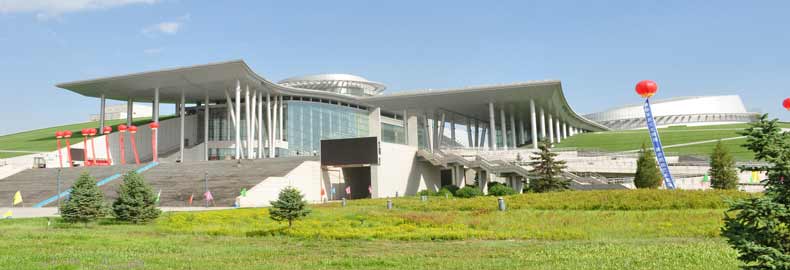
Inner Mongolia Museum is based on the rich resources of abundant fossil specimens, neontology, historical relics, and national cultures of Inner Mongolia Autonomous Region. Its second floor has four exhibition halls: Prehistoric World, Broad Plateau, Treasure Underground, and Shenzhou Spacecraft. These exhibitions introduce the generation of grassland culture. On its third floor, the four display areas (The Power of the Grassland, The Proud Son of Heaven on the Grassland, The Customs of the Grassland, and The Beacon Fire on the Grassland), like four beads of a string, show the vertical development line of grassland culture from the ancient to the modern, concise, vivid and easy to understand. On the fourth floor, the six exhibition regions (The Sunrise on the Grassland: Neolithic exhibition, Knights of Cloud and Wind: The northern nomads and their horses, Costumes on the Grassland, The Melody under the Sky: The musical and dancing history of nomads, The Magnificence of the Grassland: The paintings from Neolithic to Qing dynasty, and The Remaining Treasure on the Ancient Road: Antiques on the Silk Road, which passes Inner Mongolia) present the six highlights of grassland culture, fresh, solemn, and suiting both refined and popular taste. All these exhibitions systematically describe the complete image of Inner Mongolia on macro and micro from multi aspects and multi angels, distinctive and attractive.
Gathering strong modern elements, geographic features and national characteristics, Inner Mongolia Museum is a condensed encyclopedia of the history of ecological changes and the development of grassland civilization in the north of China in the past hundreds of millions years, and a mark of the level of regional economic development and the degree of social civilization.
Inner Mongolia region has been the big stage of northern minorities since ancient times. With unique shapes, historic relics from different times have distinct cultural characteristics. Historic relics of ancient Chinese northern prairie nomads like Huns, Donghu, Xianbei, Turks, Khitan, Tangut, Jurchen, Mongol, and so on are the characteristics of historic collections of Inner Mongolia. Besides, historic relics of Inner Mongolia Museum plays an important role in carrying forward the national culture and propagating the long history of Inner Mongolia.
Among all the ethnic collections of this museum, the collection of Mongols ranks first in all of Chinese museums. While, collections of Oroqen, Evenki, Daur, and so on reflect the characteristics of production and life from different aspects. Besides, this museum also has a considerable number of national relics of Hui, Manchu and Koreans in China.
By the pass in front of the main entrance of the museum, there’s a huge three-legged cauldron of national unity. This cauldron, round, solemn and dignified, has two large ears, three stable legs, a belly carved with exquisite patterns symbolizing the mountains and rivers of Inner Mongolia and a neck carved with fine patterns meaning flocks of cattle and sheep of Inner Mongolia. The saddle-like cauldron ears and the horse’s hoof like cauldron legs mean that Mongols are good at rose racing and archery as well as good luck and happiness to Mongols.
What to See
The Museum boasts 56,475 pieces of cultural relics, of which 635 pieces are the first-grade, including an eagle-shaped golden coronet of the Warring States Period (475-221BC) with 7.1cm in height and 192 grams in weight, and a set of golden coronet strips (consisting of 3 pieces) with 1,022.4 grams in weight. These two items were unearthed in 1972. In addition, an incense burner of the Yuan Dynasty (1271-1368) of 42.7cm high was unearthed in Hohhot in 1970.
One of the important sources of its collections are precious materials excavated from the earth as a result of archaeological research. These materials are of great speciality to the museum. The Inner Mongolia Museum is renowned for its extensive collection of fossils and dinosaur remains found in both Inner Mongolia and Outer Mongolia including a complete skeleton of a wooly rhinoceros unearthed from a coal mine in Manzhouli.
The Museum features four exhibition halls: Display of Ancient Animals’ Remains, Display of Historical Relics, Display of Folk Relics and Display of Revolutionary Relics.
Hohhot Attractions


